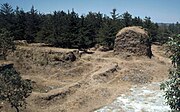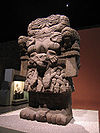Mesoamerica (Spanish: Mesoamérica) is a region and cultural area in the Americas, extending approximately from central Mexico to Belize, Guatemala, El Salvador, Honduras, Nicaragua, and Costa Rica, within which a number of pre-Columbian societies flourished before the Spanish colonization of the Americas in the 15th and 16th centuries.
As a cultural area, Mesoamerica is defined by a mosaic of cultural traits developed and shared by its indigenous cultures. Beginning as early as 7000 BC the domestication of maize, beans, squash and chili, as well as the turkey and dog, caused a transition from paleo-Indian hunter-gatherer tribal grouping to the organization of sedentary agricultural villages. In the subsequent formative period, agriculture and cultural traits such as a complex mythological and religious tradition, a vigesimal numeric system, and a complex calendric system, a tradition of ball playing, and a distinct architectural style, were diffused through the area. Also in this period villages began to become socially stratified and develop into chiefdoms with the development of large ceremonial centers, interconnected by a network of trade routes for the exchange of luxury goods such as obsidian, jade, cacao, cinnabar, Spondylus shells, hematite, and ceramics. While Mesoamerican civilization did know of the wheel and basic metallurgy, neither of these technologies became culturally important.
Among the earliest complex civilizations was the Olmec culture which inhabited the Gulf coast of Mexico. In the Preclassic period, complex urban polities began to develop among the Maya and the Zapotecs. During this period the first true Mesoamerican writing systems were developed in the Epi-Olmec and the Zapotec cultures, and the Mesoamerican writing tradition reached its height in the Classic Maya Hieroglyphic script. Mesoamerica is one of only five regions of the world where writing was independently developed. In Central Mexico, the height of the Classic period saw the ascendancy of the city of Teotihuacan, which formed a military and commercial empire whose political influence stretched south into the Maya area and northward. During the Epi-Classic period the Nahua peoples began moving south into Mesoamerica from the North. During the early post-Classic period Central Mexico was dominated by the Toltec culture, Oaxaca by the Mixtec, and the lowland Maya area had important centers at Chichén Itzá and Mayapán. Towards the end of the post-Classic period the Aztecs of Central Mexico built a tributary empire covering most of central Mesoamerica.
Selected article

Qʼumarkaj, (Kʼicheʼ: [qʼumarˈkah]) is an archaeological site in the southwest of the El Quiché department of Guatemala. Qʼumarkaj is also known as Utatlán, the Nahuatl translation of the city's name. The name comes from Kʼicheʼ Qʼumarkah "Place of old reeds".
Qʼumarkaj was one of the most powerful Maya cities when the Spanish arrived in the region in the early 16th century. It was the capital of the K'iche' Maya in the Late Postclassic Period. Archaeologically and ethnohistorically, Qʼumarkaj is the best known of the Late Postclassic highland Maya capitals. The earliest reference to the site in Spanish occurs in Hernán Cortés' letters from Mexico. Although the site has been investigated, little reconstruction work has taken place. The surviving architecture, which includes a Mesoamerican ballcourt, temples and palaces, has been badly damaged by the looting of stone to build the nearby town of Santa Cruz del Quiché.
The major structures of Qʼumarkaj were laid out around a plaza. They included the temple of Tohil, a jaguar god who was patron of the city, the temple of Awilix, the patron goddess of one of the noble houses, the temple of Jakawitz, a mountain deity who was also a noble patron and the temple of Qʼuqʼumatz, the Feathered Serpent, the patron of the royal house. The main ballcourt was placed between the palaces of two of the principal noble houses. Palaces, or nimja, were spread throughout the city. There was also a platform that was used for gladiatorial sacrifice.
Selected biography
Matthew Williams Stirling (August 28, 1896 – January 23, 1975) was an American ethnologist, archaeologist and later an administrator at several scientific institutions in the field. He is best known for his discoveries relating to the Olmec civilization.
Stirling began his career with extensive ethnological work in the United States, New Guinea and Ecuador, before directing his attention to the Olmec civilization and its possible primacy among the pre-Columbian societies of Mesoamerica. His discovery of, and excavations at, various sites attributed to Olmec culture in the Mexican Gulf Coast region significantly contributed towards a better understanding of the Olmecs and their culture. He then began investigating links between the different civilizations in the region. Apart from his extensive field work and publications, later in his career Stirling proved to be an able administrator of academic and research bodies, who served on directorship boards of a number of scientific organizations.
Did you know?
- ...that after the Aztec Coatlicue statue (pictured) was discovered, it was buried again to prevent it becoming the object of a cult?
Subcategories
Related portals
Selected image
 |
Frederick Catherwood and John Lloyd Stephens made a brief visit to the ruins of Q'umarkaj in 1840. While there, Catherwood produced a drawing of the Temple of Tohil
Featured articles
Good Topics
Good articles
 Gómez de Alvarado
Gómez de Alvarado Aztecs
Aztecs La Blanca, Peten
La Blanca, Peten Calakmul
Calakmul Bartolomé de las Casas
Bartolomé de las Casas Copán
Copán El Chal
El Chal Haʼ Kʼin Xook
Haʼ Kʼin Xook Itzam Kʼan Ahk II
Itzam Kʼan Ahk II Iximche
Iximche Kʼinich Yat Ahk II
Kʼinich Yat Ahk II Kʼinich Yoʼnal Ahk I
Kʼinich Yoʼnal Ahk I Macuahuitl
Macuahuitl Maize
Maize Manche Chʼol
Manche Chʼol Mixco Viejo
Mixco Viejo Motul de San José
Motul de San José Mundo Perdido, Tikal
Mundo Perdido, Tikal North Acropolis, Tikal
North Acropolis, Tikal Potbelly sculpture
Potbelly sculpture William H. Prescott
William H. Prescott Qʼumarkaj
Qʼumarkaj Resplendent quetzal
Resplendent quetzal Seibal
Seibal Serpent labret with articulated tongue
Serpent labret with articulated tongue Spanish conquest of Yucatán
Spanish conquest of Yucatán Spanish conquest of Chiapas
Spanish conquest of Chiapas Spanish conquest of El Salvador
Spanish conquest of El Salvador Spanish conquest of Honduras
Spanish conquest of Honduras Spanish conquest of the Maya
Spanish conquest of the Maya Tikal
Tikal Toniná
Toniná Western Mexico shaft tomb tradition
Western Mexico shaft tomb tradition Benjamin Lee Whorf
Benjamin Lee Whorf Yoʼnal Ahk III
Yoʼnal Ahk III Zaculeu
Zaculeu
Topics
WikiProjects
New articles
Rules | Match log | Results page (for watching) | Last updated: 2024-07-18 21:24 (UTC)
Note: The list display can now be customized by each user. See List display personalization for details.
- Capitulation of Gualcince (edit | talk | history | links | watch | logs | tools) by Larissæ (talk · contribs · new pages (4)) started on 2024-07-18, score: 28
- Carrillo Puerto (edit | talk | history | links | watch | logs | tools) by Moscow Mule (talk · contribs · new pages (139)) started on 2024-07-17, score: 48
- Marshall Bennett (merchant) (edit | talk | history | links | watch | logs | tools) by Charles Matthews (talk · contribs · new pages (67)) started on 2024-07-09, score: 28
- Miguel Díez de Aux (edit | talk | history | links | watch | logs | tools) by Baal Nautes (talk · contribs · new pages (2)) started on 2024-07-16, score: 70
- Symbols of Tequixquiac (edit | talk | history | links | watch | logs | tools) by Yovanmartinez (talk · contribs · new pages (10)) started on 2024-07-14, score: 26
- Third federal electoral district of Veracruz (edit | talk | history | links | watch | logs | tools) by Moscow Mule (talk · contribs · new pages (139)) started on 2024-07-12, score: 30
- Amy Sawyer (edit | talk | history | links | watch | logs | tools) by Gamaliel (talk · contribs · new pages (22)) started on 2024-07-02, score: 68
- Tropical Storm Chris (2024) (edit | talk | history | links | watch | logs | tools) by IrishSurfer21 (talk · contribs · new pages (3)) started on 2024-07-10, score: 40
- Mayans (surname) (edit | talk | history | links | watch | logs | tools) by Roastedbeanz1 (talk · contribs · new pages (106)) started on 2024-07-09, score: 28
- COCONet (edit | talk | history | links | watch | logs | tools) by Starlighsky (talk · contribs · new pages (7)) started on 2024-07-09, score: 32
- TLALOCNet (edit | talk | history | links | watch | logs | tools) by Starlighsky (talk · contribs · new pages (7)) started on 2024-07-07, score: 32
- LI Legislature of the Mexican Congress (edit | talk | history | links | watch | logs | tools) by Moscow Mule (talk · contribs · new pages (139)) started on 2024-07-07, score: 42
Associated Wikimedia
The following Wikimedia Foundation sister projects provide more on this subject:
-
 Commons
Commons
Free media repository -
 Wikibooks
Wikibooks
Free textbooks and manuals -
 Wikidata
Wikidata
Free knowledge base -
 Wikinews
Wikinews
Free-content news -
 Wikiquote
Wikiquote
Collection of quotations -
 Wikisource
Wikisource
Free-content library -
 Wikiversity
Wikiversity
Free learning tools -
 Wiktionary
Wiktionary
Dictionary and thesaurus
-

-

-

-

-
Random portal
Purge server cache












